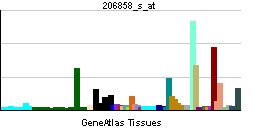HOXC6
| Homeobox C6 | |||||||||||||
|---|---|---|---|---|---|---|---|---|---|---|---|---|---|
|
File:PBB Protein HOXC6 image.jpg PDB rendering based on 1ahd. | |||||||||||||
| |||||||||||||
| Identifiers | |||||||||||||
| Symbols | HOXC6 ; HOX3; CP25; HHO.C8; HOX3C | ||||||||||||
| External IDs | Template:OMIM5 Template:MGI HomoloGene: 19533 | ||||||||||||
| |||||||||||||
| RNA expression pattern | |||||||||||||
 | |||||||||||||
| More reference expression data | |||||||||||||
| Orthologs | |||||||||||||
| Template:GNF Ortholog box | |||||||||||||
| Species | Human | Mouse | |||||||||||
| Entrez | n/a | n/a | |||||||||||
| Ensembl | n/a | n/a | |||||||||||
| UniProt | n/a | n/a | |||||||||||
| RefSeq (mRNA) | n/a | n/a | |||||||||||
| RefSeq (protein) | n/a | n/a | |||||||||||
| Location (UCSC) | n/a | n/a | |||||||||||
| PubMed search | n/a | n/a | |||||||||||
Homeobox C6, also known as HOXC6, is a human gene.[1]
This gene belongs to the homeobox family, members of which encode a highly conserved family of transcription factors that play an important role in morphogenesis in all multicellular organisms. Mammals possess four similar homeobox gene clusters, HOXA, HOXB, HOXC and HOXD, which are located on different chromosomes and consist of 9 to 11 genes arranged in tandem. This gene, HOXC6, is one of several HOXC genes located in a cluster on chromosome 12. Three genes, HOXC5, HOXC4 and HOXC6, share a 5' non-coding exon. Transcripts may include the shared exon spliced to the gene-specific exons, or they may include only the gene-specific exons. Alternatively spliced transcript variants encoding different isoforms have been identified for HOXC6. Transcript variant two includes the shared exon, and transcript variant one includes only gene-specific exons.[1]
See also
References
Further reading
- Scott MP (1992). "Vertebrate homeobox gene nomenclature". Cell. 71 (4): 551–3. PMID 1358459.
- McAlpine PJ, Shows TB (1990). "Nomenclature for human homeobox genes". Genomics. 7 (3): 460. PMID 1973146.
- Acampora D, D'Esposito M, Faiella A; et al. (1990). "The human HOX gene family". Nucleic Acids Res. 17 (24): 10385–402. PMID 2574852.
- Boncinelli E, Acampora D, Pannese M; et al. (1990). "Organization of human class I homeobox genes". Genome. 31 (2): 745–56. PMID 2576652.
- Rabin M, Ferguson-Smith A, Hart CP, Ruddle FH (1987). "Cognate homeo-box loci mapped on homologous human and mouse chromosomes". Proc. Natl. Acad. Sci. U.S.A. 83 (23): 9104–8. PMID 2878432.
- Simeone A, Mavilio F, Acampora D; et al. (1987). "Two human homeobox genes, c1 and c8: structure analysis and expression in embryonic development". Proc. Natl. Acad. Sci. U.S.A. 84 (14): 4914–8. PMID 2885844.
- Simeone A, Pannese M, Acampora D; et al. (1988). "At least three human homeoboxes on chromosome 12 belong to the same transcription unit". Nucleic Acids Res. 16 (12): 5379–90. PMID 2898768.
- Corsetti MT, Levi G, Lancia F; et al. (1995). "Nucleolar localisation of three Hox homeoproteins". J. Cell. Sci. 108 ( Pt 1): 187–93. PMID 7738096.
- Apiou F, Flagiello D, Cillo C; et al. (1996). "Fine mapping of human HOX gene clusters". Cytogenet. Cell Genet. 73 (1–2): 114–5. PMID 8646877.
- Chariot A, Castronovo V, Le P; et al. (1996). "Cloning and expression of a new HOXC6 transcript encoding a repressing protein". Biochem. J. 319 ( Pt 1): 91–7. PMID 8870653.
- Kosaki K, Kosaki R, Suzuki T; et al. (2002). "Complete mutation analysis panel of the 39 human HOX genes". Teratology. 65 (2): 50–62. doi:10.1002/tera.10009. PMID 11857506.
- Strausberg RL, Feingold EA, Grouse LH; et al. (2003). "Generation and initial analysis of more than 15,000 full-length human and mouse cDNA sequences". Proc. Natl. Acad. Sci. U.S.A. 99 (26): 16899–903. doi:10.1073/pnas.242603899. PMID 12477932.
- Gerhard DS, Wagner L, Feingold EA; et al. (2004). "The status, quality, and expansion of the NIH full-length cDNA project: the Mammalian Gene Collection (MGC)". Genome Res. 14 (10B): 2121–7. doi:10.1101/gr.2596504. PMID 15489334.
- Ramachandran S, Liu P, Young AN; et al. (2005). "Loss of HOXC6 expression induces apoptosis in prostate cancer cells". Oncogene. 24 (1): 188–98. doi:10.1038/sj.onc.1207906. PMID 15637592.
- Hori Y, Gu X, Xie X, Kim SK (2006). "Differentiation of insulin-producing cells from human neural progenitor cells". PLoS Med. 2 (4): e103. doi:10.1371/journal.pmed.0020103. PMID 15839736.
- Kimura K, Wakamatsu A, Suzuki Y; et al. (2006). "Diversification of transcriptional modulation: large-scale identification and characterization of putative alternative promoters of human genes". Genome Res. 16 (1): 55–65. doi:10.1101/gr.4039406. PMID 16344560.
- Zhang X, Hamada J, Nishimoto A; et al. (2007). "HOXC6 and HOXC11 increase transcription of S100beta gene in BrdU-induced in vitro differentiation of GOTO neuroblastoma cells into Schwannian cells". J. Cell. Mol. Med. 11 (2): 299–306. doi:10.1111/j.1582-4934.2007.00020.x. PMID 17488478.
External links
- HOXC6+protein,+human at the US National Library of Medicine Medical Subject Headings (MeSH)
This article incorporates text from the United States National Library of Medicine, which is in the public domain.
| This protein-related article is a stub. You can help Wikipedia by expanding it. |